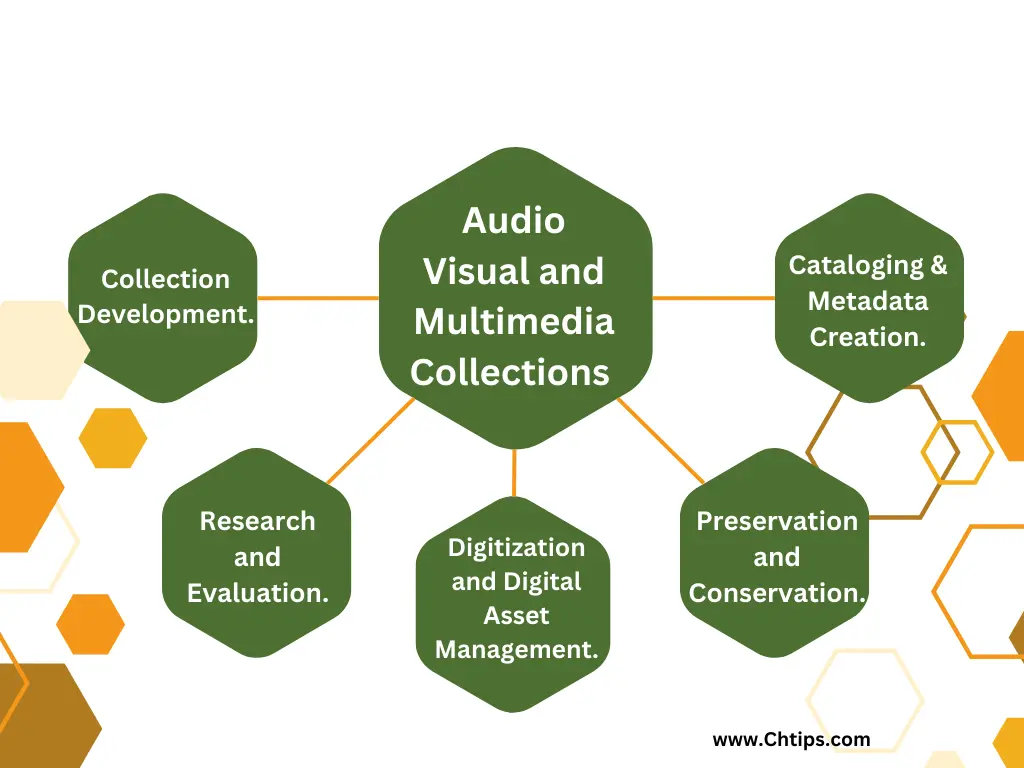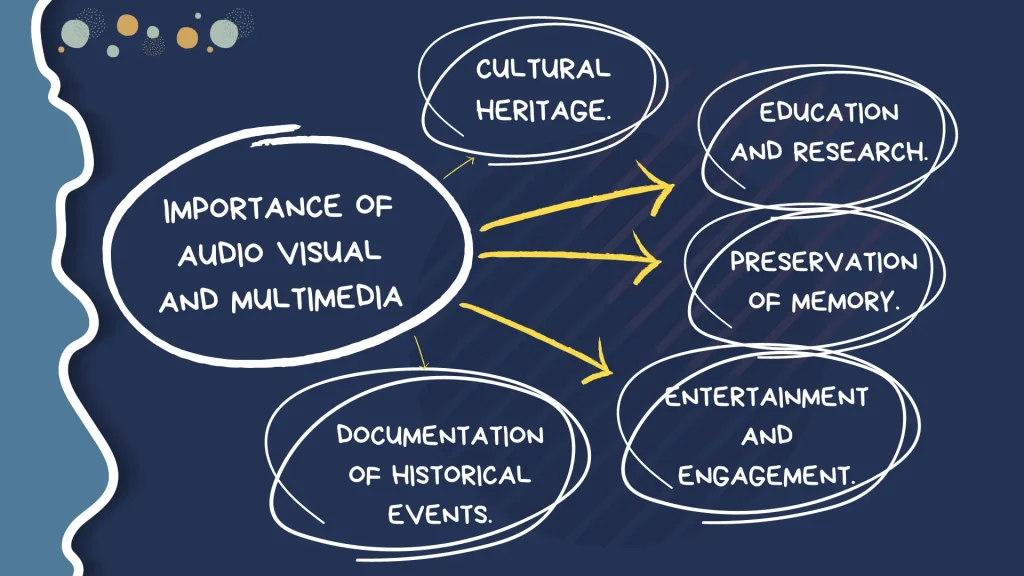Introduction to Audio Visual and Multimedia Collections
Audio Visual and Multimedia Collections Specialists refer to the section where the resources such as sound, pictures, videos, sound recordings, photographs, films, designs, and multimedia | digital content are collected and managed in various institutions or organizations.
Audio Visual and Multimedia Collections specialists are used and utilized in different organizations such as libraries, archives, educational institutions, and media organizations.
These collections are protected, safeguarded, and made reliable, accessible to authenticate users.
Audio-visual and multimedia collections are used in research, cultural preservation, and educational and historical investigations.
These resources serve various purposes, including diverse studies, research projects, education, and entertainment. Specialists in the field of collections can also seek opportunities in the field of e-learning and education.
What is Audio Visual and Multimedia Collections Specialists
Audio Visual and Multimedia Collections Specialists are professionals skilled in managing, handling, using and utilizing audiovisual and multimedia content.

They often provide their services to organizations such as museums, libraries, and educational institutes.
They are also skilled in playing with audio-visual resources such as films, videos, sound recordings, photographs, digital media, digital content, and interactive multimedia content.
Candidates must be skilled in improved and modern audio-visual and multimedia technologies for better job opportunities and great salaries.
There are significant sectors in which audio-visual and Multimedia Collections Specialists can offer their services.
- Collection Development.
- Cataloging and Metadata Creation.
- Preservation and Conservation.
- Digitization and Digital Asset Management.
- Research and Evaluation.

1. Collection Development.
Audio Visual and Multimedia Collections Specialists gather information and material related to audio-visual and multimedia for the development and growth of any business and organization.
These professionals heavily rely on digital information for improved and enhanced performance
2. Cataloging and Metadata Creation.
Cataloguing and metadata creation is an efficient method for accessing the collections. They also are indulged in arranging resources in a structured manner.
They follow the rules and regulations assigned to them more profoundly to improve performance.
3. Preservation and Conservation.
Conserving and preservation of most valuable resources such as films, videos, photographs, audio recordings, and digital media.
This digital information must be preserved for future generations for more productivity and knowledge sharing.
This valuable information can be preserved and kept safe using and implementing some proper storage, careful handling, and archival-grade storage materials and handling.
These information storages can be retrieved whenever needed and requested.
4. Digitization and Digital Asset Management.
Digitization and Digital Asset Management are extensively used in preserving and storing audio-visual and multimedia collections.
In digitization, analogue formats such as videos, films, and audio recordings are converted into digital formats.
Using digitization can help preserve a long time with accessibility and reliability. The data can be retrieved with ease using digitization.
5. Research and Evaluation.
Audio-visual and multimedia management can be used in research and evaluation with the latest trends in advanced technology. Digital information’s used to understand information and knowledge.
With the help of research and evaluation, users can gain insight, access, digitization, and make intelligent decisions.
5 Importance of Audio Visual and Multimedia Collections
There is significant importance in audio-visual and multimedia collections. Some of them are included.

- Cultural Heritage.
- Education and Research.
- Preservation of Memory.
- Entertainment and Engagement.
- Documentation of Historical Events.
Useful Video: Audio Visual And Multimedia Collection Specialist
How to Become an Audio Visual And Multimedia Collection Specialist
To become an audio-visual and multimedia collection specialist, you must be aware of the latest trends and news in the respective fields.
You must be skilled with a relevant degree from an authorized college or university.
Below I have discussed some of the legitimate steps in becoming a skilled audio-visual and multimedia collection specialist professional.
- Obtain a relevant degree from authorized colleges and universities.
- Gain technical skills and knowledge.
- Develop communication and interpersonal skills.
- Stay updated on industry trends.
- Developing continues learning with adaptive nature.
- Practice and gain experience.
- Consider professional certifications.
- Develop organizational and cataloguing skills.
- Built a good portfolio.
- Built networking.
- Making contact with professionals in the same field.
What Does an Audio Visual Multimedia Collections Specialists Do?
The audio-visual and multimedia content is managed, handled and preserved by audio-visual multimedia experts and specialists.
This specialist mainly offers services in libraries, archives, museums, educational institutions, or media organizations.
Some of the significant tasks and operations Audio-Visual Multimedia Collections Specialists perform are included below.
- Collection development.
- Preservation and conservation.
- Cataloguing and metadata management.
- Digitization and digital asset management.
- Policy and strategy development.
- Collection maintenance and quality control.
- Reference and research assistance.
- Collaboration and outreach.
- Stay updated on industry trends.
- Training and supervision.
What are the Duties and Responsibilities of Audio-Visual Technicians?
The role and duties of audio visual technician can differ entirely depending on the business and organization you are working
- Equipment setup and maintenance
- Operation of audio-visual systems.
- Technical support.
- Media production and editing.
- Event coordination.
- Safety and compliance.
- Troubleshooting and problem-solving.
- Documentation and inventory management.
Role of Audio Visual and Multimedia Collections Specialists in Organizations
Below I have mentioned some of the significant roles of audio-visual and multimedia collections specialists.
- Collection management.
- Preservation and conservation.
- Access and retrieval.
- User support and assistance.
- Technology integration.
- Metadata and cataloguing standards.
- Advocacy and outreach.
- Digital preservation and curation.
- Collaborations and partnerships.
- Training and education.
Audio Visual And Multimedia Specialists PDF Download
Qualifications Required to Become an Audio Visual and Multimedia Collections Specialist
| 1 | Relevant Degree From Authorized College and University. |
| 2 | Skilled and Professional. |
| 3 | Experience. |
| 4 | Good Communication Skills. |
| 5 | Knowledge of Audiovisual and Multimedia Technologies |
Job Opportunities & Designation for Audio Visual and Multimedia Collections Specialists
| # | Designation | Salary Approx |
|---|---|---|
| 1 | Audio Visual Support Specialist – IT. | $ 50,000 Per Annum |
| 2 | Visual Information Specialist. | $70,000 to $1,00,000 |
| 3 | Audio Visual Specialist. | $25,000 to $50,000 |
| 4 | Audio Visual Specialist(Video Editor). | $55,000 to $75,000 |
| 5 | Multimedia Specialist – Communications & Marketing. | $55,000 to $70,000 |
| 6 | Multimedia Specialist, Office of Communications. | $60,000 to $70,000 |
| 7 | Social Media Specialist. | ———-!!!————- |
Emerging Trends in Audio Visual and Multimedia Collections
There are several emerging trends in audio-visual and multimedia collections. Some of them are mentioned and included in this section.
- Digital preservation and access.
- Born-digital collections.
- Artificial intelligence and machine learning.
- Virtual and augmented reality.
1. Digital Preservation and Access.
In this modern generation, the world is shifted to digital formats.
Digital content such as videos, films, photographs, and audio recordings are preserved and accessed using digital audio-visual and multimedia materials.
2. Born-Digital Collections.
The born-digital collections such as web archives, social media content, and digital art are new challenges of audio-visual and multimedia collections.
3. Artificial Intelligence and Machine Learning.
Modern technology like artificial intelligence [AI], machine learning [MI], and cloud computing are modern technology that can be used in Audio Visual and Multimedia Collections for better performance, accessibility and efficiency.
4. Virtual and Augmented Reality.
Virtual reality (VR) and augmented reality (AR) are the advanced and enhanced technologies used and utilized for user satisfaction and engagement in audio-visual and multimedia collections.
Recommended Reading
Frequently Asked Questions [FAQs] on Audio Visual And Multimedia
Is audio-visual a good job?
Yes, it is a good choice.
What qualifications are required to become an audio-visual and multimedia collections specialist?
1. Advanced and skilled professional related to audio-visual and multimedia technologies and formats
2. Awareness of library science.
3. Enhanced knowledge regarding preservation and conservation techniques
How do audio-visual and multimedia collections specialists ensure the preservation of delicate materials
1. Handling and processing storage.
2. Taking preventive conservative measures.
3. Utilizing specialized equipment and tools for cleaning and repair.
What are the challenges faced by institutions in managing and providing access to audio-visual and multimedia collections
1. Ensuring copyright rules and regulations.
2. Using digital prevention techniques.
3. Maintaining security.
How do emerging technologies impact the role of audio-visual and multimedia collections specialists
1. Using and utilizing modern technology like machine learning, artificial learning, and cloud computing.
2. Using enhanced tools for improved performance.
3. Enhancing access to collections
What are the career opportunities for audio-visual and multimedia collections specialists
1. Job opportunities in libraries, museums, archives, and cultural institutions.
2. research opportunities.
3. Specializations in specific technologies.
Get In Touch
There is an ever-increasing demand for audio and visual content with the help and assistance of new, updated technology in education and e-learning.
There is a significant need for professionals skilled in handling and accessing audio-video content for businesses and organizations.
Such professionals have excellent communication and technical skills and are aware of preserving and sharing cultural heritage through diverse multimedia formats.
I have also written and compiled some articles on computers and telecommunications, and please go through them.
I hope you will like reading it.
All the questions and queries related to the What is Audio Visual and Multimedia Collections Specialists, with examples and images, have been answered here.
If you have any questions related to Audio Visual and Multimedia Collections Specialists Shape.
Don’t hesitate to contact me, and if you need to add, remove or update anything from the article, please let me know in the comment section or via email.
I will be more than happy to update the article. I am always ready to correct myself.
Please share this article with your friends and colleagues; this motivates me to write more on related topics.
!!! Thank You !!